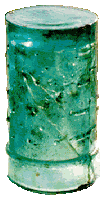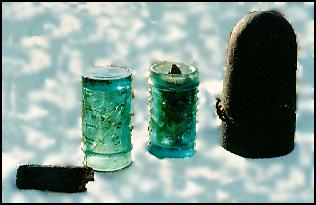
[ Home | What's New | Articles ]
 |
Wade Type Telegraph Insulators from Jackson County |
[You may want to read this prologue by
Keith Roloson![]() ,
and take a look at the associated photograph
of the group of wades found! Wow!]
,
and take a look at the associated photograph
of the group of wades found! Wow!]
During the summer months of 1994 I had the good fortune to recover two wade type CD 723 threadless telegraph insulators while searching for civil war relics near Bridgeport, Alabama. At the time I stumbled across these blown glass gems, my knowledge of insulators of any type was minimal. I have since learned that this particular type insulator is somewhat rare and considered a very desirable collectable. Realizing this, I felt that individuals involved in collecting and studying glass insulators might enjoy reading about the discovery of these items.
Having had a life long interest in civil war history, hunting for relics from this long ago war became a personal hobby years ago. until the summer of 1994, I had enjoyed only moderate success at this endeavor; most of my recoveries had came from well known sites long ago picked over by other relic hunters. In late June, 1994, while hunting a federal encampment bordering a low lying marsh, it occurred to me that in all probability this area may not have been constantly below water level during the civil war years. Many interesting and well preserved relics had been recovered from just such areas in Virginia by other relic hunters persistent enough to make the attempt. One look at my mornings meager finds indicated that I had little to lose by spending a few hours floundering around in sticky muck and water.
 I will not go into great detail of
just what all came from this area during the next several months. Anyone involved in
searching for relics, insulators, or most any type collectable realizes the value of
research in recovering the looked for items. However, there is absolutely nothing that
compares with just plain old occasional good, dumb, blind luck when you are fortunate
enough for it to come your way. Simply stated, my efforts in this quagmire were handsomely
rewarded. I found modern trash, old trash, rocks, junk and, fortunately, the hoped for
relics. Liberally mixed in with modern trash and junk were civil war era bottles, bullets,
gun parts, leather items, buckles, a few artillery shells, and misc. other items,
including the two wade type glass insulators.
I will not go into great detail of
just what all came from this area during the next several months. Anyone involved in
searching for relics, insulators, or most any type collectable realizes the value of
research in recovering the looked for items. However, there is absolutely nothing that
compares with just plain old occasional good, dumb, blind luck when you are fortunate
enough for it to come your way. Simply stated, my efforts in this quagmire were handsomely
rewarded. I found modern trash, old trash, rocks, junk and, fortunately, the hoped for
relics. Liberally mixed in with modern trash and junk were civil war era bottles, bullets,
gun parts, leather items, buckles, a few artillery shells, and misc. other items,
including the two wade type glass insulators.
 The first wade insulator surfaced
in late June. Receiving a strong signal from my metal detector, I began working my arm
down into the bottom mud. Digging holes proved quite impossible in this area. I gently
pulled what I felt to be an artillery shell from about two feet deep in the muck. What
emerged was a hollow wooden cylinder rounded on one end and banded with a heavy gauge iron
wire near the open end. Washing the mud away revealed a greasy substance smeared over and
inside the wooden cylinder. Tucked inside was a blown in mold hollow green glass cylinder
with a series of embossed dots and bars encircling the outer sides. Inside the glass
cylinder was a grease covered hand hewn wooden pin. It wasn't especially hard to deduce
that the object was an early telegraph insulator in a remarkable state of preservation.
Obviously, both the thick mud and greasy substance covering the insulator components
served to aid in this preservation. Sometime later, another identical glass insulator,
sans wooden cylinder, was recovered from an area not far removed from this site. This
insulator, a perfect twin to the first, also contained a wooden pin with what appears to
be a glob of grease sealed inside.
The first wade insulator surfaced
in late June. Receiving a strong signal from my metal detector, I began working my arm
down into the bottom mud. Digging holes proved quite impossible in this area. I gently
pulled what I felt to be an artillery shell from about two feet deep in the muck. What
emerged was a hollow wooden cylinder rounded on one end and banded with a heavy gauge iron
wire near the open end. Washing the mud away revealed a greasy substance smeared over and
inside the wooden cylinder. Tucked inside was a blown in mold hollow green glass cylinder
with a series of embossed dots and bars encircling the outer sides. Inside the glass
cylinder was a grease covered hand hewn wooden pin. It wasn't especially hard to deduce
that the object was an early telegraph insulator in a remarkable state of preservation.
Obviously, both the thick mud and greasy substance covering the insulator components
served to aid in this preservation. Sometime later, another identical glass insulator,
sans wooden cylinder, was recovered from an area not far removed from this site. This
insulator, a perfect twin to the first, also contained a wooden pin with what appears to
be a glob of grease sealed inside.
As I previously stated, my knowledge of these items was rudimentary at best when I
discovered them. Simple intuition told me that these items were undoubtedly very nice
relics. A friend in my relic hunting club, the Chattanooga area relic and historical
association, provided me with a confirmation that the insulators were indeed of civil war
era manufacture (the threadless interior apparently indicates this) . Subsequent
communication with
Keith Roloson![]() of the Dixie
Jewels Insulator Club has served to confirm this information. Keith also indicated
that this type insulator had rarely if ever been found this far south. We both speculate
that these insulators were probably carried south by federal troops while serving in this
region during the civil war.
of the Dixie
Jewels Insulator Club has served to confirm this information. Keith also indicated
that this type insulator had rarely if ever been found this far south. We both speculate
that these insulators were probably carried south by federal troops while serving in this
region during the civil war.
Part of the personal satisfaction I derive from relic hunting is sharing my finds with others having similar interests. I also realize and appreciate the historical value to be derived from providing information on the recovery of such items. Hopefully, this information will prove helpful to others involved in the study and preservation of insulators and related material.
![]() Return to the Research Articles
page
Return to the Research Articles
page
If you have questions or comments, please use this Feedback Form.
Last updated Tuesday, February 27, 1996